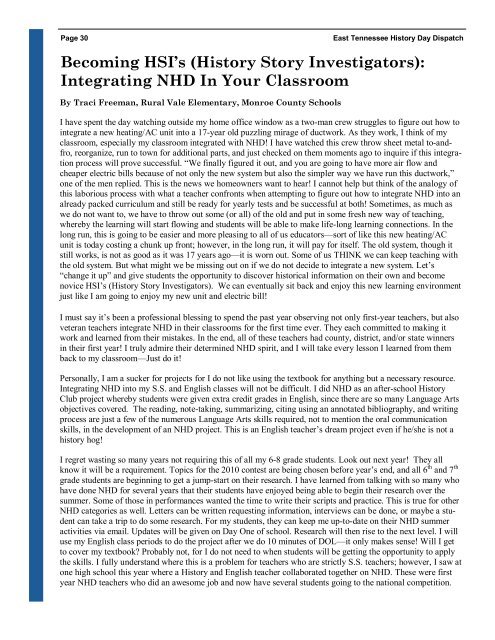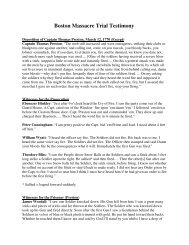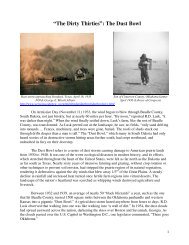Volume 1, Issue 1 - Teach American History
Volume 1, Issue 1 - Teach American History
Volume 1, Issue 1 - Teach American History
Create successful ePaper yourself
Turn your PDF publications into a flip-book with our unique Google optimized e-Paper software.
Page 30<br />
By Traci Freeman, Rural Vale Elementary, Monroe County Schools<br />
East Tennessee <strong>History</strong> Day Dispatch<br />
Becoming HSI’s (<strong>History</strong> Story Investigators):<br />
Integrating NHD In Your Classroom<br />
I have spent the day watching outside my home office window as a two-man crew struggles to figure out how to<br />
integrate a new heating/AC unit into a 17-year old puzzling mirage of ductwork. As they work, I think of my<br />
classroom, especially my classroom integrated with NHD! I have watched this crew throw sheet metal to-andfro,<br />
reorganize, run to town for additional parts, and just checked on them moments ago to inquire if this integration<br />
process will prove successful. “We finally figured it out, and you are going to have more air flow and<br />
cheaper electric bills because of not only the new system but also the simpler way we have run this ductwork,”<br />
one of the men replied. This is the news we homeowners want to hear! I cannot help but think of the analogy of<br />
this laborious process with what a teacher confronts when attempting to figure out how to integrate NHD into an<br />
already packed curriculum and still be ready for yearly tests and be successful at both! Sometimes, as much as<br />
we do not want to, we have to throw out some (or all) of the old and put in some fresh new way of teaching,<br />
whereby the learning will start flowing and students will be able to make life-long learning connections. In the<br />
long run, this is going to be easier and more pleasing to all of us educators—sort of like this new heating/AC<br />
unit is today costing a chunk up front; however, in the long run, it will pay for itself. The old system, though it<br />
still works, is not as good as it was 17 years ago—it is worn out. Some of us THINK we can keep teaching with<br />
the old system. But what might we be missing out on if we do not decide to integrate a new system. Let’s<br />
“change it up” and give students the opportunity to discover historical information on their own and become<br />
novice HSI’s (<strong>History</strong> Story Investigators). We can eventually sit back and enjoy this new learning environment<br />
just like I am going to enjoy my new unit and electric bill!<br />
I must say it’s been a professional blessing to spend the past year observing not only first-year teachers, but also<br />
veteran teachers integrate NHD in their classrooms for the first time ever. They each committed to making it<br />
work and learned from their mistakes. In the end, all of these teachers had county, district, and/or state winners<br />
in their first year! I truly admire their determined NHD spirit, and I will take every lesson I learned from them<br />
back to my classroom—Just do it!<br />
Personally, I am a sucker for projects for I do not like using the textbook for anything but a necessary resource.<br />
Integrating NHD into my S.S. and English classes will not be difficult. I did NHD as an after-school <strong>History</strong><br />
Club project whereby students were given extra credit grades in English, since there are so many Language Arts<br />
objectives covered. The reading, note-taking, summarizing, citing using an annotated bibliography, and writing<br />
process are just a few of the numerous Language Arts skills required, not to mention the oral communication<br />
skills, in the development of an NHD project. This is an English teacher’s dream project even if he/she is not a<br />
history hog!<br />
I regret wasting so many years not requiring this of all my 6-8 grade students. Look out next year! They all<br />
know it will be a requirement. Topics for the 2010 contest are being chosen before year’s end, and all 6 th and 7 th<br />
grade students are beginning to get a jump-start on their research. I have learned from talking with so many who<br />
have done NHD for several years that their students have enjoyed being able to begin their research over the<br />
summer. Some of those in performances wanted the time to write their scripts and practice. This is true for other<br />
NHD categories as well. Letters can be written requesting information, interviews can be done, or maybe a student<br />
can take a trip to do some research. For my students, they can keep me up-to-date on their NHD summer<br />
activities via email. Updates will be given on Day One of school. Research will then rise to the next level. I will<br />
use my English class periods to do the project after we do 10 minutes of DOL—it only makes sense! Will I get<br />
to cover my textbook? Probably not, for I do not need to when students will be getting the opportunity to apply<br />
the skills. I fully understand where this is a problem for teachers who are strictly S.S. teachers; however, I saw at<br />
one high school this year where a <strong>History</strong> and English teacher collaborated together on NHD. These were first<br />
year NHD teachers who did an awesome job and now have several students going to the national competition.






